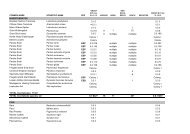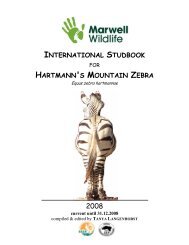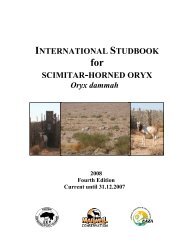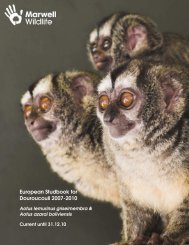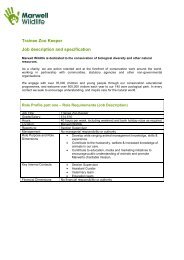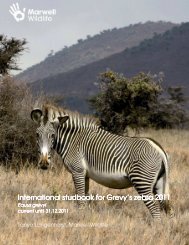international studbook hartmann's mountain zebra - Marwell Zoo
international studbook hartmann's mountain zebra - Marwell Zoo
international studbook hartmann's mountain zebra - Marwell Zoo
You also want an ePaper? Increase the reach of your titles
YUMPU automatically turns print PDFs into web optimized ePapers that Google loves.
orn <strong>Zoo</strong><br />
Hartmann’s <strong>mountain</strong> <strong>zebra</strong> Conservation & Research<br />
Should you know of any conservation or research projects going on in the field or in zoos, please let me<br />
know, so I can include this information here.<br />
Sarcoid problems in Hartmann’s <strong>mountain</strong> <strong>zebra</strong><br />
Due to a large number of animals in the EEP being affected by sarcoids, the EEP coordinator carried out a<br />
survey in 2007 to gather information on this disease from all member institutions. The results were presented<br />
at the EAZA Conference in Warsaw 2007. A summary of this survey is presented further down.<br />
I would ask all EEP institutions to report any new cases of sarcoids as well as treatment methods and their<br />
success or failure to the EEP coordinator.<br />
Should anybody have any more information on this disease and its treatment, I would appreciate as much<br />
information as possible on TanyaL@marwell.org.uk .<br />
Photo © Nordhorn <strong>Zoo</strong><br />
SARCOIDS – A COMMON PROBLEM IN HARTMANN’S MOUNTAIN ZEBRA?<br />
1 ) What are they?<br />
• Tumours in the equid family, which affect the skin.<br />
• Variable in appearance, location and growth rate<br />
• Not linked to sex or species<br />
• Seldom affect a horse’s usefulness<br />
• Treatment not always necessary, but possible<br />
Sarcoids in HMZ behave differently from those in domesticated animals:<br />
• There appears to be species predilection for HMZ<br />
• Usually located around mammary glands (♀) or sheath (♂)<br />
• Lumps more invasive, often ulcerate, bleed, attract flies<br />
• Can interfere with suckling in mares, or with breeding in stallions<br />
• Can lead to euthanasia due to bad condition of affected animal<br />
2) EEP survey results<br />
• 5 zoos reported total of 17 (5.12.0) animals recorded with this disease<br />
• Age range 3.5 yrs – 19yrs, most common ~8-8.5 yrs at first signs<br />
• All in genital region: around udder, on/around penis, some between hind legs<br />
• Physical effects: some animals no signs, others in poor condition, obvious discomfort and pain<br />
• Behavioural effects: 4 zoos reported no change in behaviour of affected animal towards others or vice<br />
versa. One zoo reported increased aggression towards others, which eventually lead to change of<br />
dominance in group<br />
3) Sarcoids – treatments<br />
• Generally operation; freeze/thaw cryosurgery<br />
o Can leave an extensive area of exposed subcutaneous tissue<br />
which then results in healing difficulty.<br />
• Injections (Roferon A) and cytotoxic ointment;<br />
• “Sarcoid” cream provided by Liverpool University, which is<br />
extensively used in domestic horses. Recipe of cream is well<br />
guarded secret.<br />
o Cream repeatedly injected into lumps in min. 2 weeks intervals.<br />
Severe inflammatory response -> painkillers given. Lumps turn<br />
necrotic and fall off over time. Not permanent cure, but could<br />
Photo © Dvur Kralove <strong>Zoo</strong><br />
control lump size and possibly allow suckling of foal.<br />
o Effect: in most cases sarcoids return, in same place after weeks, months or years. Nine cases<br />
euthanised.<br />
AII





